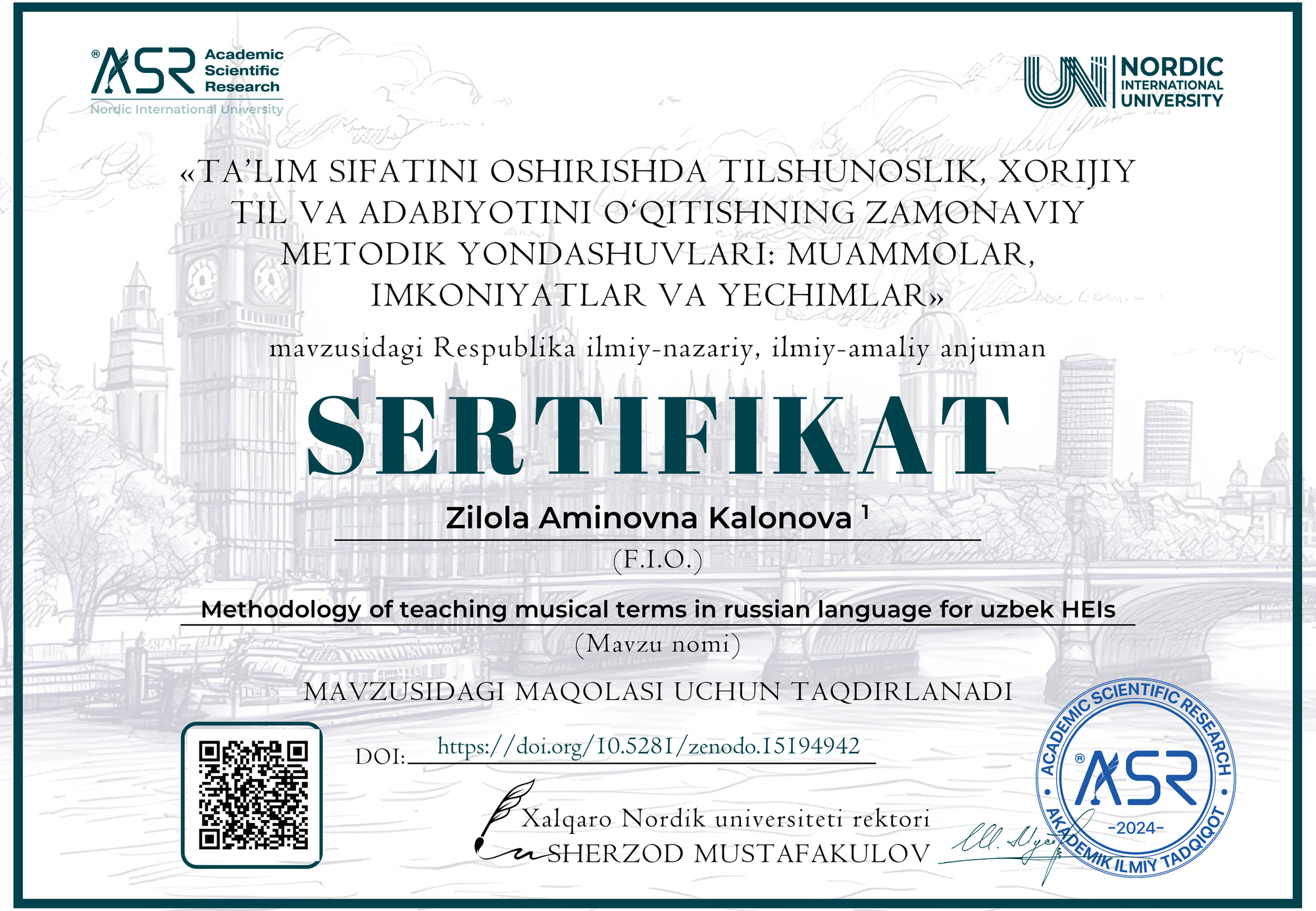Zilola Aminovna Kalonova 1

DOI: https://doi.org/10.5281/zenodo.15194942
Google scholar: https://scholar.google.com/scholar?hl=ru&as_sdt=0%2C5&q=%22METHODOLOGY+OF+TEACHING+MUSICAL+TERMS+IN+RUSSIAN+LANGUAGE+FOR+UZBEK+HEIs%22&btnG=
Zenodo community: https://zenodo.org/records/15194942
Nordic_press journal: https://research.nordicuniversity.org/index.php/nordic/article/view/2330
MAQOLANI YUKLAB OLISH
SERTIFIKATNI YUKLAB OLISH
REVIEW:
The article "Methodology of Teaching Musical Terms in Russian Language for Uzbek HEIs" by Zilola Aminovna Kalonova presents a comprehensive study of the challenges and strategies involved in teaching musical terminology in the Russian language to students in Uzbek higher educational institutions. The paper is well-structured, offering both theoretical insight and practical methods, which are vital for understanding how musical terms function within a bilingual educational context.
Summary and Key Points
The article begins by emphasizing the importance of music in education, particularly its role in the cultural, intellectual, and emotional development of students. It notes that musical terminology is fundamental for musical literacy, as these terms guide students in understanding and interpreting musical works accurately. This is especially significant in Uzbekistan, where bilingualism is common, and students often encounter musical terms in both Russian and Uzbek. The author acknowledges that while musical terms are often of European origin, such as Italian, German, and French, the Russian language plays a critical role in the education of music students in Uzbekistan.
One of the primary challenges highlighted is the lack of direct equivalents for many musical terms in Uzbek, requiring a nuanced approach to teaching these concepts. Kalonova suggests that integrating Uzbek cultural elements, particularly those from the rich tradition of Uzbek folk music, could facilitate a deeper understanding of these terms. She proposes a bilingual approach that not only teaches the Russian musical terms but also connects them to cultural contexts that are familiar to students, enhancing both comprehension and retention.
In terms of methodology, the paper advocates for the creation of glossaries, the use of interactive teaching methods such as group discussions and role-playing, and the incorporation of audiovisual materials to improve learning. The author also stresses the importance of translation exercises, as these help students build a solid understanding of musical terminology in both languages.
Strengths of the Article
One of the key strengths of the article is its focus on practical teaching strategies. Kalonova's suggestions, such as creating a glossary of musical terms and using interactive methods, are grounded in pedagogical theory and reflect an understanding of the challenges faced by students in bilingual environments. Additionally, the inclusion of real examples of musical terms such as fermata, crescendo, and diminuendo provides clear illustrations of how these terms can be explained to students in a way that is both accessible and engaging.
The paper’s examination of the bilingual nature of musical education in Uzbekistan is also insightful. By recognizing the cultural and linguistic complexities involved, the author offers a well-rounded perspective on how to balance the authenticity of musical traditions with the practical needs of students. This consideration of both language and culture is crucial for developing effective teaching methods.
Areas for Improvement
Although the article presents valuable recommendations for teaching musical terminology, it could further benefit from a discussion of specific case studies or empirical data on how these methods have been implemented in practice. For example, evidence of the effectiveness of bilingual glossaries or the impact of audiovisual materials on student learning would strengthen the argument. Additionally, the paper could explore in more detail how technology, such as online resources or digital tools, can enhance the teaching of musical terminology in the context of modern education.
Conclusion
In conclusion, Zilola Aminovna Kalonova's article provides a thoughtful and well-researched examination of the methodology for teaching Russian musical terms to students in Uzbek higher education institutions. It offers valuable insights into the challenges of bilingual musical education and suggests practical, culturally sensitive solutions. By combining linguistic and cultural considerations with modern teaching methodologies, the paper contributes significantly to the discourse on music education in bilingual environments. The recommendations outlined in the article are both practical and forward-thinking, making it a useful resource for educators seeking to enhance their teaching of musical terminology.



